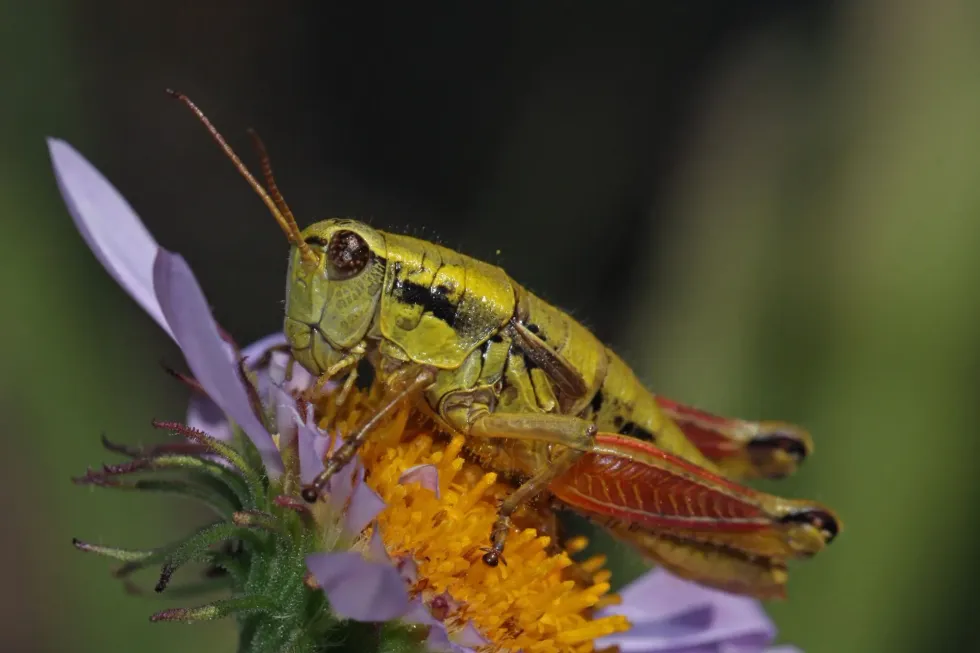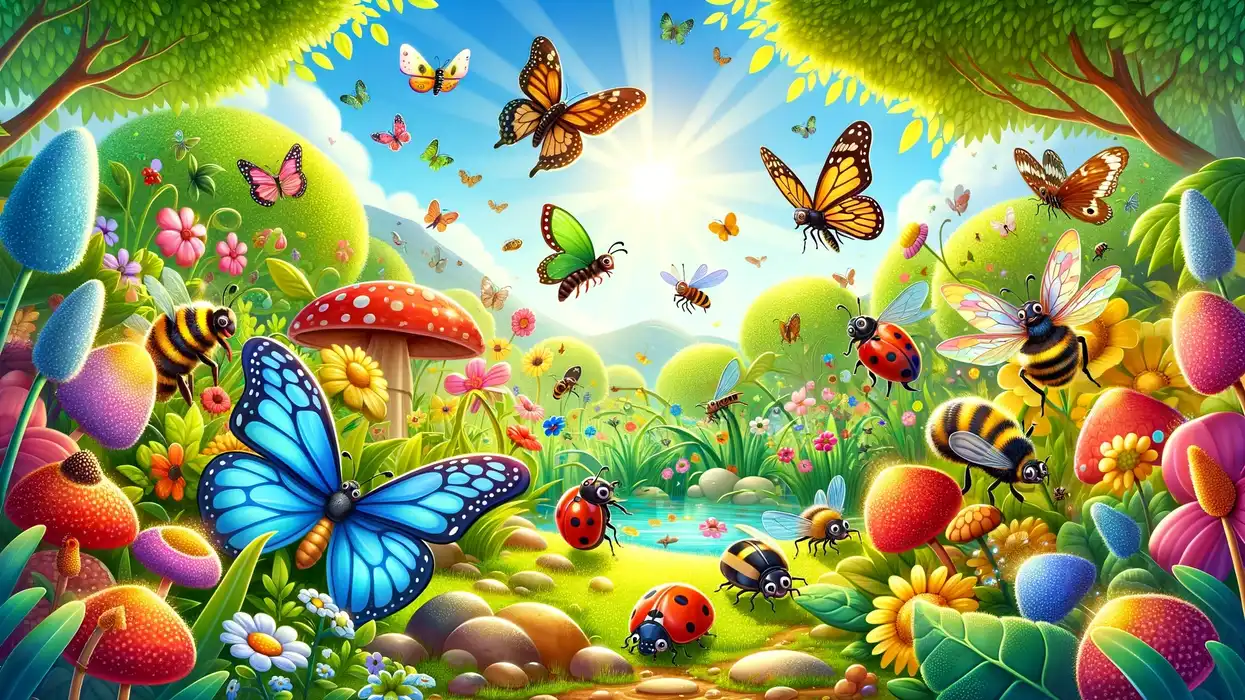The Orthoptera meaning has been derived from the ancient Greek word 'orthos' meaning straight and 'ptera' meaning wings. This order comprises grasshoppers, locusts, crickets, and other related insects like katydids.
They are mostly found in tropical regions and forests and also certain Orthoptera are aquatic and semi-aquatic.
The Orthoptera tends to live alone but some of them like grasshoppers tend to form groups and swarms to attack crops and thus, they are known as pests. These Orthopterans have cylindrical bodies with extended hind legs and a pair of two wings that overlap the abdomen.
The forewings tend to be narrower than the hind wings.
The reproduction or Orthoptera metamorphosis is incomplete as there are only three stages- eggs, nymph, and adult and is different from that of a butterfly which goes through complete metamorphosis. The eggs are laid in the soil or among the vegetation.
The Orthoptera diet ranges from herbivores to omnivores to strictly predatory. While some only eat grass and leaves, others prey on small insects and sometimes eat their own mate.
Certain differences exist among the members of this order like the katydids or long-horned have long and thin antennae while mole crickets do not have long antennae and the color of the bodies differ of these insects.
There are a lot of fascinating things to know about Orthopterans and one out of many Orthoptera examples is that a grasshopper is known for its jumping abilities. To know more about these insects read on and also go through katydid and Jerusalem cricket facts.
Orthoptera Interesting Facts
What type of animal is an Orthoptera?
Orthoptera is an order of insects and this includes grasshoppers, locusts, and crickets.
What class of animal does an Orthoptera belong to?
The Orthoptera belongs to the Insecta class of animals.
How many Orthoptera are there in the world?
There has been no specific number of Orthoptera in the world recorded but there are about 20,000 species of this animal.
Where does an Orthoptera live?
These Orthoptera are found in almost all countries in tropical forests.
What is an Orthoptera's habitat?
This species is found in semi-arid and tropical regions and lowland tropical forests and grasslands. Species of Orthoptera habitat include all terrestrial habitats like rock crevices, subterranean burrows, caves, rainforest treetops, alpine mountain ranges. Certain species also inhabit aquatic places, marches, or semi-aquatic regions. Meadows or savannas are also populated by most of the species.
Who do Orthoptera live with?
These species tend to live alone, but they are also known to form groups or swarms and attack crops.
How long does an Orthoptera live?
The lifespan of an Orthoptera is typically one year.
How do they reproduce?
The life cycle of an Orthoptera is paurometabolous or incomplete metamorphosis. The mating process includes sounds and thus, species produce different songs. The eggs are laid in the ground or soil or on vegetation and are incubated in the chamber in the female's body.
The Orthoptera life cycle has three phases or stages, that is, egg, nymph, and adult. The eggs hatch and nymphs are born.
These nymphs look similar to mature or fully-developed ones but they lack wings and differ in coloration and size. The number of molts varies across species. Few of the Orthopterean species have females only, and reproduction happens without fertilization.
What is their conservation status?
The conservation status of this species is Not Extinct. They are believed to be in rather large numbers across the planet.
Orthoptera Fun Facts
What do Orthopteras look like?
The Orthoptera usually have cylindrical bodies and four legs with extended hind legs and an enlarged hind femur. The muscle structure is adapted for jumping. The Orthoptera mouthparts and jaws are adapted to kill and chew plants and animals.
They may possess large eyes with or without ocelli, this depends on the species. These insects also have thread-like antennae that have multiple joints and are of variable lengths. Crickets and katydids have large antennae whereas certain grasshoppers have short antennae.
There are three segments on the thorax. The first and the third are larger and the second segment is smaller.
These insects have two pairs of wings that overlap the abdomen. The forewings tend to be narrower than the hindwings and are also hardened or leathery at the base. The hind wings have straight and cross veins.
How cute are they?
Though they are small and have different colored bodies, these small insects are not considered cute.
How do they communicate?
Most of the communication happens through varied sounds which are similar to birdcalls. These sounds are produced for different purposes like attracting mates, defend territories and raise an alarm when seized by a predator.
The varied pitch and frequency are used to communicate information. The stridulation process is common among species like crickets, katydids. They are also known to use olfactory and tactile signals.
How big is an Orthoptera?
Orthopteras are medium-sized insects. The body length of species ranges from 0.3-3.5 in (7-90 mm).
How fast can an Orthoptera move?
Species of the order Orthoptera are recorded to move at around 200 mph.
How much does an Orthoptera weigh?
While the average weight or the weight range of species of the order Orthoptera is unknown, it has been recorded that the heaviest of all species of Orthoptera weighs 0.2 lb (71 g).
What are their male and female names of the species?
There are no specific names of the male and female of the species of the order Orthoptera.
What would you call a baby Orthoptera?
The baby Orthoptera that hatches out of the egg is known as a nymph.
What do they eat?
Short-horned grasshoppers are known to be herbivores and feed on leaves and parts of plants. Many species are obligatory grass feeders who live in savannas and grasslands. Some species tend to feed on lichens and mosses on the leaves and trees.
Crickets, katydids, and other relatives range from herbivores to omnivores to strictly predatory. These species feed on nectar, pollen, small animals like caterpillars, lizards, snails, and frog eggs. Mole crickets tend to gather and store germinating seeds for later consumption.
Are they dangerous?
While Orthoptera species can bite, they are not considered to be poisonous and dangerous. Certain species are known to be pests such as grasshoppers to crops and can damage an entire field in a day. A lot of damage is caused by the direct consumption of plants by Orthopteras.
Would they make a good pet?
While these Orthopterans are uncommon as pets, for some people who wish to keep this Orthopteran as a pet, it is quite straightforward as certain species can be easy to find, inexpensive, and free if you catch them. The food requirements are easy to fulfill.
These orthopterans can be kept in a glass or plastic terrarium according to size with adequate light.
The Orthoptera grasshopper can be given any kind of grass and leaves that are moist as they do not eat dry grass and leaves.
You need to be gentle with the grasshoppers as they can jump high. You should also be aware of the lifespan of the grasshoppers or other Orthoptera families as most of these do not live long.
Did you know...
Certain Orthopterans can eat their mates or other orthopterans if they are very hungry.
Grasshoppers have the ability to jump 20 times farther than the length of their body due to their strong hind legs which work like catapults.
Though katydids, crickets, and grasshoppers belong to the same order of Orthoptera, there exist certain differences among these species.
Grasshoppers move during the day and thus, their color is similar to that of grass and flowers. Crickets tend to move at night and hence, their bodies are dark in color.
Katydids spend most of their time on leaves and thus, are often leaf-colored and their wings also look like leaves and the vein structure on these Orthoptera wings is similar to that of leaves and sometimes has brown spots just like leaves.
Katydids, also known as long-horned and crickets, have long and thin antennae while grasshoppers have short and thick antennae.
A grasshoppers' auditory organs are not located on the head instead its located on the abdomen.
Mole crickets do not have long antennae but are recognized by the long front legs that are used for digging.
Locusts and grasshoppers are consumed in many areas of Asia, America, and Africa as they are a high source of protein and according to the Bible, John the Baptist ate locusts and honey in the wild.
Grasshoppers tend to spit liquids in self-defense.
Due to grasshoppers' ability to break down cellulose and lignin without producing greenhouse gases, is a subject of research as it could be an alternative biofuel.
There are 20,000 species of Orthoptera and they belong to around 30 families.
How many songs can Orthoptera produce?
The songs of Orthoptera are considered to be inborn and species-specific and are also stereotyped. Most of them are known to produce three types of songs, which are calling, courtship, and rival songs. But there are other insects like grasshoppers that produce five songs which are copulation song, normal song, courtship song, assault song, and a rivals' duet.
What is an Orthoptera's egg-laying organ called?
The egg-laying organ in an Orthoptera is known as the ovipositor and it has varied structure and form and can be used to distinguish or identify different species.
Here at Kidadl, we have carefully created lots of interesting family-friendly animal facts for everyone to discover! Learn more about some other arthropods including puss moth, or American dagger moth.
You can even occupy yourself at home by drawing one on our Orthoptera coloring pages.










